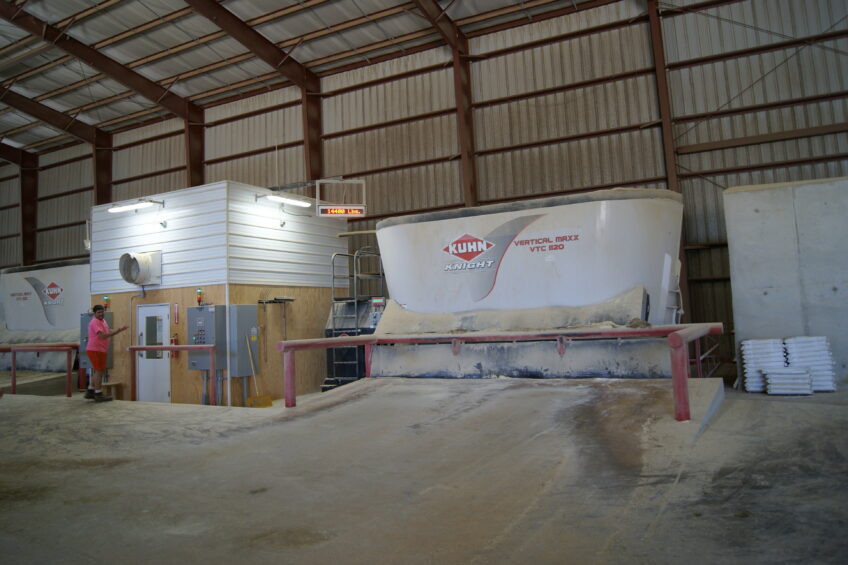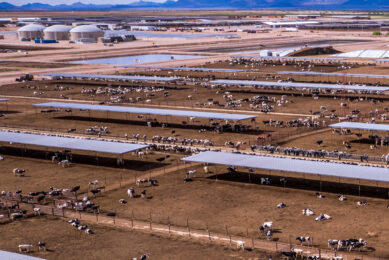Dairy farmer built a smart feed centre to control shrink

The amount of feed you pay for is often not the same amount that is delivered at the feed fence and actually eaten by the animals. The difference is known as shrink. A dairy farmer in Wisconsin, USA has built a smart feed centre to keep shrinkage to a minimum.
|
Feed costs represent a large part of the production costs for milk, so dairy farmers are on top of losing as little feed as possible. A commonly used term in the dairy industry is ‘shrink’, meaning the loss of feed ingredients, labour and time associated with feeding and loss due to reduced accuracy of feeding. The raw materials that a farmer buys or harvests are not the same weights or volumes that are actually being fed to the animals. Shrink can therefore be seen as the loss of resources that never have the potential for economic return.
Without shrink management losses mount quickly
“Its impact often goes unnoticed because the operation does not have systems and protocols in place to measure or monitor shrink. However, if the operation is not actively managing shrink, then what starts out as an abnormal loss becomes commonplace and part of the routine cost of doing business,” explains David Greene, Technical Services Specialist at Diamond V. He adds: “Without shrink management, losses can mount quickly. For example, for a farm with a 1,000-cow herd, where feed cost is US$ 7 per cow per day, figure a cost of $ 25,550 per year for every 1% shrink. At 8% shrink, that’s additional cost of $ 204,400 annually for the herd.”

Shrink control becomes more common
There are many areas on a dairy operation where shrink can occur. The 4 main areas are:
- forage (before, during, and after harvest)
- in the feed centre
- during loading and mixing of the TMR
- in the barn during and after feed delivery
Dairy farms that are located in areas with colder climates or excessive rainfall may benefit from placing the entire feed centre under a roof to eliminate moisture and wind problems. The layout and design of such a feed centre is very specific for each farm and can be part of an effective control plan to reduce shrink. Mr Greene designed the feed centre of the Statz Brothers dairy farm in Marshall, Wisconsin, about 20km east of Madison. The farm – which is run by Joe Statz, his 2 sons and his 2 cousins, Troy and Wesley — milks a total of 4,400 cows on two locations (close to each other). The farm was previously run by Joe’s father and uncle, hence the name Statz Brothers. The home farm was expanded with the second location in 2015, where the majority of the cows (3,300) are housed and milked. When this location came into the hands of the Statz family, the family decided to renovate the farm and build a dedicated feed centre to minimise shrink and hence optimise the dairy farm operation. Diamond V had developed the so-called TMR Audit in 2008 and the company has expanded this service with designing tailor made feed centres at dairy farms.

The TMR Audit
This is a system to monitor and improve the cattle feeding process as well as the consistency and homogeneity of the ration consumed by each animal. It addresses feedstuffs storage, ingredient preparation and proportioning, TMR mixing, ration presentation, and utilisation. A well-designed feed centre that minimises shrink and optimises the quality of the raw materials is a logical part of the holistic approach to optimise feeding practices, hence minimising costs for the farmer.
Key points when designing a feed centre
Greene explains that there are key things to remember when designing a feed centre. Just to name a few:
- Delivery trucks – you have to be able to unload various types of delivery trucks so that you can take advantage of opportunity ingredient buys. Certain delivery trucks can have lower freight rates because they can haul more weight.
- Under cover – the facility should also be completely under roof-cover and out of the weather. Wind is a major cause of increased shrink.
- Monitoring system – also important is to include a monitoring system to make sure the efficiencies you are trying to achieve are being accomplished, to find bottlenecks that may be occurring, and to troubleshoot problems that might occur.

All of these key points have been incorporated by the Statz family in their feed centre. The building that houses the feed centre is a little more than 3,400 square meters, with a total of 10 bunkers for all the different raw materials, 2 stationary mixers and an operations room. Each day the feed centre mixes 37 loads, or a little over 450 metric tons of feed for heifers and cows at both locations.
Shrink reduced from 10% to 2-3%
Todd Follendorf from Cornerstone Dairy Nutrition in Waunakee, Wisconsin is the nutritionist at the Statz Brothers farm. He explains why he is so happy with the new feed facility: “Shrink control has been the main reason why we built the whole facility. Before, we had shrink percentages of around 10% every single day. Now, we have reduced this to 2% to 3%.”

First-in first-out method
Mr Follendorf also points out that the raw materials are protected from weather events like storms or rain. “In the old situation, we stored part of the raw materials uncovered. You can imagine that part of the material was prone to be blown or washed away. So with the new feed centre, we have better consistency of the product, less shrink, and we can mix more accurately. It is the first-in first-out method. The trucks remain outside, dump the raw materials and leave. This way, the older material is pushed forward to the inside and used first. Commodities like corn, grains and forage are added almost every day. Some other raw materials that are used less are filled up every week or so. In about a week, the volume of one whole bunker is refreshed.”
Diet formulation and mixing
One dedicated employee is responsible for the mixing. He manages the operations room, situated in between the 2 mixers. The time that a mixer wagon comes in empty and comes back again after bringing the ration to the cows takes about 25 minutes. Each mixer wagon has a capacity of 13,600 kilogrammes. When the wagon picks up the feed at the feed centre, it keeps on mixing it all the way up till feeding it to the cows. Mr Follendorf further explains that he formulated 5 different diets for the farm: for the lactating cows, post fresh cows, dry cows and heifers (2 different diets).

“Nutritionists like me formulate diets, but this is the theory. You still have to prepare the ration, mix it, and bring it to the cows.” And it is important that the TMR is consistent for every cow in the group being fed. “The goal is to bring theory and practice as close as possible and actually feed what you have paid for. The feed centre is part of reaching this goal. But also for example pushing back the feed at the feed fence is important.” At the Statz farm, every 2 hours on average, the feed is pushed back (manually or by a robot), as this increases feed intake and minimises losses again.
Saving on feed costs
For many dairy farmers, production costs against the milk prices remain a worry, so keeping feed costs under control is pivotal. According to Diamond V, the concept of minimising shrink is quite a well-known topic in the US and more dairy farms around the country are building tailor-made feed centres to keep losses and feed costs under control. “Shrink has always been a concern, but mostly a term used in the feed industry, by feed millers,” Mr Greene says. “But we notice that it has become a common topic at farm level as well. More US farmers are starting to think about monitoring the feed better. So when we think of smart ways to improve production and efficiency at dairy farms, you have to start with making feed management more efficient.” For the Statz Brothers’ dairy farm, the investment in the feed centre is a ‘no brainer’. A quick calculation shows that a lot of money can be saved. With an average feed cost of $ 8 per cow per day, combined with a 5% reduction in shrink, the 4,400 cow Statz Brothers’ herd can save, in theory, over $ 0.5 million per year on feed costs.
Join 13,000+ subscribers
Subscribe to our newsletter to stay updated about all the need-to-know content in the dairy sector, two times a week.


 Profile
Profile







